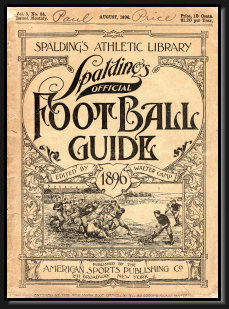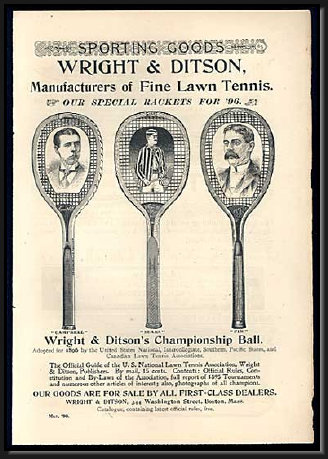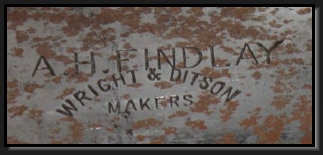The patriarch of the Spalding/Wright & Ditson empire, Albert Spalding, died on September 9, 1915 at the age of 65. James Walter Spalding, Albert's brother, took the helm of the company, and James's son H. Boardman Spalding was added as a stakeholder of Wright & Ditson. In 1918, the stakeholders consolidated Wright & Ditson and Victor Sporting Goods into a single company, Wright & Ditson-Victor Company. The two companies maintained two manufacturing facilities, Victor's Springfield, Massachusetts factory and Wright & Ditson's in Boston. All sporting goods produced from these facilities thereafter were stamped with a new Victor, Wright & Ditson logo.
Under the terms of the merger, Wright & Ditson's Boston retail store would continue to operate solely under the Wright & Ditson name. Similarly, Charles Whitney, founder of Victor, would continue to operate his Denver, Colorado store as Whitney Sporting Goods Company.
Under the terms of the merger, Wright & Ditson's Boston retail store would continue to operate solely under the Wright & Ditson name. Similarly, Charles Whitney, founder of Victor, would continue to operate his Denver, Colorado store as Whitney Sporting Goods Company.
Perhaps the most important acquisition by Spalding in 1892 was control over Wright & Ditson's official guide and rule book publications. By the mid-1890's, official Spalding guides replaced almost all of the major sports guides previously produced by Wright & Ditson. Spalding masterfully nurtured this symbiotic relationship with each sports' athletic associations, whose endorsement and adoption of the official Spalding guide served as a defacto endorsement of Spalding's athletic equipment. This relationship, and the elimination of competition through acquisition, helped cement Spalding's reputation as the gold standard in sporting goods in the first half of the twentieth century. For example, in 1892 Spalding began producing the official guide for the Intercollegiate Football Association and the Spalding's J5 football was named the official ball of the association that same year. The J5 would hold this distinction until the mid-1930's and Spalding football equipment would dominate the American sporting goods market for decades. Wright & Ditson, would continue to manufacture its own independent line of sporting goods and remain a major supplier of baseball and football uniforms and tennis equipment in the northeast. However, the company's advertisements and catalogs for baseball and football equipment after 1892 featured Spalding products as their premium offerings.
To promote Wright & Ditson's sale of golf equipment, in 1897 Spalding hired Alexander Findlay to run the company's golf department. Findlay, a Scottish immigrant, had constructed the first golf course in the U.S.

A New Era

Ditson's Passion Play
Wright & Ditson - Victor Sporting Goods Merger
In compiling our catalogue for this year we have combined all the best features in every department for the game of Base Ball. We have made a special arrangement with the Victor Base Ball Factory for their specialties, and will sell in all our stores their celebrated line of Base Balls, Bats, Mitts, Gloves, Masks and Protectors. All these goods, with the exception of the balls, will have our name stamped on them, guaranteeing the quality, for if they were not the best it is possible to make we would not sell them. The reason our name does not appear on the balls is that we do not want too many names on them, but we guarantee the quality just the same. The Wright & Ditson line of bats has never been equalled, and we are certain that the Victor, Lajoie, Demon and Little Giant Bats will give the most critical player a selection such as no one else can offer. The Wright & Ditson Uniforms have always been in a class by themselves—thirty-nine years' experience as club outfitters speaks volumes. The shoes sold by us are worn by America's greatest players, and have been during our entire business career.
An excerpt from the 1910 Wright & Ditson Baseball Guide:
Wright & Ditson line of baseball bats got a boost in the early 1900's from an endorsement deal signed with Philadelphia and Cleveland star Napoleon Lajoie. The company secured a patent for the unique, double handle style bat used by Lajoie in 1903. The bat was design to give hitters greater control over the ball. While the design didn't catch on with most players, Wright & Ditson produced and sold this and other Lajoie endorsed bats over the following decade.
In 1910, Wright & Ditson announced the formation of a partnership with Victor Sporting Goods of Springfield, Massachusetts. Victor's baseball factory would produce their specialties, namely baseballs, bats, mitts, and gloves, for Wright & Ditson, and the goods would thereafter bear the Wright & Ditson logo. It is possible that the announcement may have followed Spalding's acquisition of a controlling interest in Victor. The partnership resulted in a resurgence in several lines of Wright & Ditson's sports equipment. After nearly two decades of primarily retailing Spalding baseball gloves, footballs and football helmets, Wright & Ditson began introducing their own models (produced by Victor) to compete with Spalding's offerings.
In 1910, Wright & Ditson announced the formation of a partnership with Victor Sporting Goods of Springfield, Massachusetts. Victor's baseball factory would produce their specialties, namely baseballs, bats, mitts, and gloves, for Wright & Ditson, and the goods would thereafter bear the Wright & Ditson logo. It is possible that the announcement may have followed Spalding's acquisition of a controlling interest in Victor. The partnership resulted in a resurgence in several lines of Wright & Ditson's sports equipment. After nearly two decades of primarily retailing Spalding baseball gloves, footballs and football helmets, Wright & Ditson began introducing their own models (produced by Victor) to compete with Spalding's offerings.
By the early 1900's, Wright & Ditson's stakeholders included George Wright, his son and former tennis champion Beals Wright, John Morrill, Albert Spalding, and James Walter Spalding. While John Morrill was responsible for the day-to-day operation of the company and George Wright was the figurehead, A.G. Spalding & Brothers controlled 99.7% of the company's shares. In owning Wright & Ditson, A.J. Reach, and A.G. Spalding, Albert Spalding was able to manipulate the sporting goods market to maximum profits while creating the perception of choice for the consumer. In the early 1900's, Spalding would become the country's primary supplier of football equipment, Reach was best known for its baseball offerings, and Wright & Ditson's tennis and golf lines were considered the best in the nation.

in 1887. His duties at Wright & Ditson would included designing golf clubs and courses, and to grow the game in the U.S. Findlay's reputation and club designs would elevate Wright & Ditson's standing as one of the premier golf equipment manufacturers in the first half of the twentieth century. Over his career, Findlay would design well over 200 golf courses, with some estimates as high as 500.
In January, 1928, A.J. Reach & Co.'s founder, Al Reach passed away. Later that year, Spalding consolidated Reach and the Wright & Ditson-Victor Co. into A.J. Reach, Wright & Ditson, Inc. The new company would be based in California, where George Wright, now in his 80's, resided. John Morrill stepped down as Wright & Ditson's manager and was replaced by J.A. Addelman, Wright & Ditson's west coast manager. Wright & Ditson's product line was thereafter narrowed to tennis and golf equipment while the Reach brand produced the company's baseball and football equipment.
In 1934, all assets of A.J. Reach, Wright & Ditson were assigned to Spalding Sales Corporation. Spalding would continue to produce Wright & Ditson tennis and golf equipment until the 1970's.
In 1934, all assets of A.J. Reach, Wright & Ditson were assigned to Spalding Sales Corporation. Spalding would continue to produce Wright & Ditson tennis and golf equipment until the 1970's.
A.J. Reach, Wright & Ditson
While Wright & Ditson would become a supplier of athletic goods to the entire nation, throughout its history the company shared a special relationship with the city and professional baseball teams of Boston. Wright & Ditson supplied uniforms for every Boston team from 1871 until 1907, including the Red Stockings, Red Caps, Beaneaters, Nationals, and Americans. Through its retail stores in Cambridge and Worcester, Massachusetts and Providence, Rhode Island, the company manufactured and sold uniforms for a variety of sports for the leading colleges in New England, including Harvard, Brown, Boston College, Amherst, Dartmouth, Williams, and Bowdoin. In 1898, Wright & Ditson's retail store and headquarters, which had relocated to 344 Washington Street in 1893, was renovated and expanded to four floors in 1915.
The same year he was inducted into the Baseball Hall of Fame with its inaugural class, George Wright died in 1937, at the age of 90. In the early years of professional baseball, Wright was known as the "King of Baseball," and the greatest shortstop of his time.
George Wright's Legacy
Wright & Ditson Tennis Racquet Ad, c. 1895
Alexander Findlay Golf Club, c. 1900


City Roots
Questions or comments? Please email me at:
“George Wright never had any equal as a fielder, base runner and batsman. All his qualifications taken together, he was really in a class by himself, and I do not know of a ball player today who was ever entitled to be considered in the same breath with him.”
Hall of Famer Jim O’Rourke
Wright left an indelible mark on how the game was played. He revolutionized the shortstop position by playing behind second and third base instead of in front, and developed the strategy of sharing the middle base with the second baseman on double plays. As a player, Wright led the Boston Redstockings to six championships in eight seasons. Wright perhaps had an even greater impact on the game by what he accomplished off the field. Through Wright & Ditson, George was a pioneer in the marketing and promotion of sports and exercise as essential parts of American life.
"There is no man in America better known, or who has contributed more to the cause of true athletics than Mr. Wright."
Boston Daily Globe, 1890
Maker Spotlight:
The History of Wright & Ditson
The History of Wright & Ditson
Chris Hornung
November 24, 2015
Page 3
November 24, 2015
Page 3







